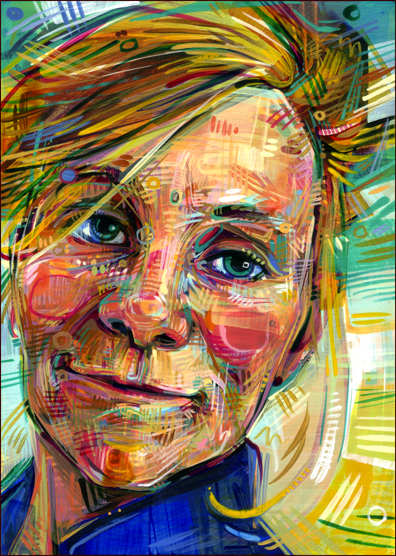If you're new here, you may want to subscribe to my RSS feed. Thanks for visiting!
Recently I had the pleasure of stumbling across the Vimeo Channel of artist Gwen Seemel. After watching some of her videos (both in English and to test my high school French-I failed by the way 😉
I visited her blog and was hooked!
Gwen’s art mixed with her insightfully honest and thought provoking blog posts allow the readers to be lost in a beautiful world, watching a creative live her dream!
I reached out to Gwen about an interview for my “Sharing Your Story” series over at Big Dreaming Entrepreneur and she was kind enough of to agree. Her work as a creative was very inspiring to me so I decided to share it here as well. Enjoy!
1. Tell us a bit about you-have you always been into art and painting?
Growing up, my older brother was always teasing me, in the way that siblings tend to do. One day when I was 6 and he was 9, we were both drawing. At some point, he leaned over to inspect my piece of paper and declared “that’s really pretty good.” A compliment from a tough critic–and specifically a critic whom I completely adored–was all it took. I was hooked on art!
2. You talk on your blog about doing portraits and how challenging an undertaking it can be-I believe you refer to it as a kind of insanity in one post. How did you decide to focus on this type of art?
Portraiture was a very natural direction for me to take. I liked painting the people in my life because it was a way to connect two things I loved: the people and my art!
And when I started to paint portraits professionally, I learned just how powerful that connection is. A lot of art tends to distance itself from everyday life and from anyone outside the elitist art community, but portraiture has a way of overcoming those distances. It makes my art about more than just me, meaning it’s automatically more interesting!
3. You have been working full-time as an artist for 8 years now-how did you do it? Were you transitioning from another career or leaving another job?
I began working as an artist directly out of college. My parents invited me to live with them until I could get my business going, and those 18 months of rent-free living were essential to beginning my career. They allowed me to build up some capital, and they gave me the chance to find my rhythm as an artist without having to work another job.
Over the years, I’ve discovered that though making a living as an artist is a skill it’s more useful to think of it as a discipline. The most important thing is just keep at it.
I describe my method in 4 steps:
1) Make a lot of art.
2) Show the best of that art to lots of people.
3) Be friendly.
4) Repeat.
And it’s the last step that most people get hung up on.
I go into more detail about my 4 step method here:
4. I am always fascinated with people’s daily routines-do you have one? What do your days look like? Some people who work from home have clear definitions of “work time” and “down time.” Do you?
I don’t differentiate between work time and down time. I view my whole life as either all work or all play! Everything I do flows back into my art one way or another and everything I create impacts who I am and my relationships with others, so it’s impossible to tease out what is artist-me and what is me-me.
I also tend to avoid a routine. That’s part of what I love about working for myself: I can work on whatever I want whenever it feels right to. It keeps me fresh and always excited about what I’m doing.
That said, if paintings aren’t working out and I’m not in the mood to write (for the book I’m working on, for my blog, for grant applications and the like), I’ll usually do one of three things: cook a meal, read a book, or take a walk. They’re my favorite ways to procrastinate while doing something productive!
5. Was it hard for you to make the shift to being a full time artist in that, did you have fears of sharing your work and wonder “can I do it?”
Every time I put together a new series of paintings, I wonder if I can do it. Art-making is a difficult and delicate thing. The way I’ve learned to cope with the self-esteem issues that arise with such a vulnerable undertaking is by separating myself from my work. If someone doesn’t like what I do, it doesn’t mean that they have a problem with me. Thinking this way allows me to listen to feedback and learn from it, instead of getting distracted by hurt feelings.
6. Who inspires you?
As a portraitist, I have an easy answer: it’s my subjects who inspire my work! It’s true in an obvious physical/visual sense, but also emotionally. Being an artist can be a lonely endeavor, but being a portrait artist means there’s always someone new around, someone to get me out of my head and show me the world from a new perspective.
7. Do you belong to other artistic groups or have many friends who are also artists? Does that make it easier/harder having so many people who understand what is involved in your work?
My partner is an artist, though he’s a storyteller and a musician rather than a painter, and having him around is invaluable to me. I love being able to talk through concepts with him and get feedback about my work. We’re close enough that he knows a lot about my projects, but he’s still a different person from me so he can bring some informed perspective to the discussion.
Where other creatives are concerned, I tend to have a little less luck. I don’t believe in copyright, and that means that I’m difficult to be around if you’re the kind of artist who is set on claiming ownership of your work. I’ll refrain from including a rant in this interview, but for artists who are interested I wrote about how I make sure my art doesn’t get ripped off on the Internet here:
8. What have been your biggest challenges in being self-employed as an artist?
In 2009, I was diagnosed with endometriosis, a disease which causes chronic pain. The daily discomfort of my illness sometimes makes it a challenge to get work done. When it does, I am reminded to be grateful that I can work for myself. Because I’m a freelancer, my boss is understanding about my needing to take time off, and that’s a luxury that a lot of women with my disease don’t have.
For more information about endometriosis, an illness which affects millions of women, go here:
9. What are the biggest rewards you have experienced with being a self-employed artist?
For me, the most important thing about being an artist has always been that I get to do whatever I want all day every day. That kind of freedom is truly delicious.
For more information about Gwen’s work please visit her blog at GwenSeemel.com





